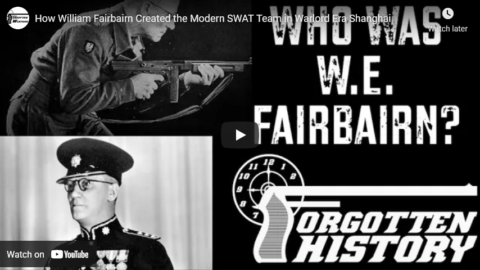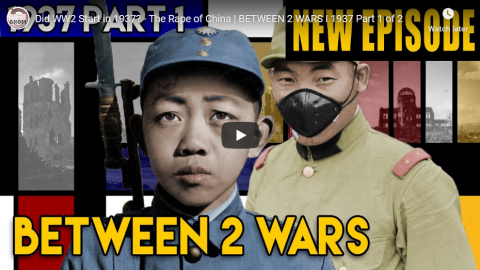Real Time History
Published 21 Jul 2023In 1937 Japan invaded the Republic of China after already annexing Manchuria in 1931. With the international settlements in Shanghai, the military support through Nazi Germany and the Soviet Union and the general escalation of the war, many argue that 1937 marked the start of the Second World War in Asia.
(more…)
July 22, 2023
Did Japan Start WW2 in 1937?
February 25, 2022
Total War NOW – WAH 053 – February 1943, Pt. 2
World War Two
Published 24 Feb 2022Germany declares total (unconditional war) putting its economy on a full war footing over three years into the war. Given the unconditional war they are already waging, and the resistance and opposition they now face, it’s unclear what it shall mean.
(more…)
September 7, 2021
How William Fairbairn Created the Modern SWAT Team in Warlord Era Shanghai
Forgotten Weapons
Published 1 Jun 2021William E. Fairbairn is best known for his work with Eric Sykes and their “Commando” knife design during World War Two. However, Fairbairn spent some 33 years in the Shanghai Municipal Police, working his way up from a beat constable to Assistant Commissioner. There he was responsible for the SMPD adopting truly forward-thinking fighting methods, and he essentially invented the modern SWAT team (the “Reserve Unit”, which Fairbairn led for 10 years). He combined expertise in formal marksmanship, instinctive practical shooting, and hand-to-hand combat schools (including jiu-jitsu and judo) into a comprehensive training program like no other on earth at the time.
Book references:
The World’s First SWAT Team, by Leroy Thompson:
https://amzn.to/2TrYiNvGentleman & Warrior, by Peter Robins:
https://amzn.to/3vuODn9http://www.patreon.com/ForgottenWeapons
https://www.floatplane.com/channel/Fo…
Cool Forgotten Weapons merch! http://shop.forgottenweapons.com
Contact:
Forgotten Weapons
6281 N. Oracle 36270
Tucson, AZ 85740
February 7, 2020
Did WW2 Start in 1937? – The Rape of China | BETWEEN 2 WARS I 1937 Part 1 of 2
TimeGhost History
Published 6 Feb 20201937 marks the beginning of the Second Sino-Japanese War. And whether or not this is the “actual” starting point of World War Two, it definitely was a devastating conflict which led to the deaths of hundreds of thousands and the displacement of millions.
Join us on Patreon: https://www.patreon.com/TimeGhostHistory
Subscribe to our World War Two series: https://www.youtube.com/c/worldwartwo…
Hosted by: Indy Neidell
Written by: Francis van Berkel
Directed by: Spartacus Olsson and Astrid Deinhard
Executive Producers: Bodo Rittenauer, Astrid Deinhard, Indy Neidell, Spartacus Olsson
Creative Producer: Joram Appel
Post-Production Director: Wieke Kapteijns
Research by: Francis van Berkel
Edited by: Daniel Weiss
Sound design: Marek Kaminski
Research and Writing Assistance: Rune Vaever HartvigSources:
Photo of Shanghai 1932. from 2013 Adrienne Livesey, Elaine Ryder and Irene BrienColorizations by Daniel Weiss
Soundtracks from Epidemic Sound:
– “The Beast” – Dream Cave
– “Split Decision” – Rannar Sillard
– “March Of The Brave 10” – Rannar Sillard – Test
– “Disciples of Sun Tzu” – Christian Andersen
– “The Inspector 4” – Johannes Bornlöf
– “Death And Glory 1” – Johannes Bornlöf
– “Magnificent March 3” – Johannes Bornlöf
– “Trapped in a Maze” – Philip Ayers
– “Last Man Standing 3” – Johannes Bornlöf
– “Not Safe Yet” – Gunnar Johnsen
– “Under the Dome” – Philip Ayers
– “First Responders” – Skrya
– “The Charleston 3” – Håkan ErikssonA TimeGhost chronological documentary produced by OnLion Entertainment GmbH.
From the comments:
TimeGhost History
1 day ago (edited)
Okay, so we’re not actually telling you unequivocally that World War Two started in 1937. Technically things only got global when the European powers became involved with the backing of their colonies (and in Britain’s case, the Commonwealth). What we are trying to tell you here is that how you periodize or define a historical event depends on whose perspective you are writing from. The people of Eastern Asia experienced World War Two as the progressive escalation from 1937 (or even 1931), to 1941, to 1945. In the same way the German invasion of Poland in September 1939 marks for many in Europe the outbreak of war, the Marco Polo Bridge Incident in July 1937 marks for many in Eastern Asia the start of the very same event. Let us know what you think of this in the comments. Does it make you think differently about the war?
Cheers, Francis.
June 21, 2011
Chinese high speed trains to run slower than planned
They’ll still qualify as high speed trains, but they’ll only travel at speeds up to 250kph instead of the 385kph they were designed to achieve. The problem is safety concerns:
The Chinese government has announced a significant lowering in the top speed its hallmark Beijing-to-Shanghai high-speed train will be allowed to run at when it opens later this month after a review of safety, shoddy workmanship and corruption.
The new service halving the 10-hour rail travel time between China’s political and business centres was meant to be the flagship project of a massive $400-billion program to give the country the most extensive bullet train network anywhere.
But the announcement last week by the Railway Ministry that trains on the new line will only be permitted to run at about 250 kilometres per hour instead of the projected 380 km/h has taken the bloom off the opening.
The restriction follows a review by officials stemming from the sacking in February of the railway minister, Liu Zhijun, and the deputy chief engineer of the department, Zhang Shuguang.
The concerns about safety are not at all unwarranted:
Contractors are said to have skimped on using expensive hardening agents when making the concrete for the rail bases. These ties are predicted to crumble within a few years. And there is said to have been a similar shortage of strengthening ingredients included in the concrete used to build bridges and their supporting columns.
A high speed train requires the right-of-way to be engineered to a much higher standard than ordinary passenger or freight rail lines. If too many corners have been cut in this construction, it would be insane to allow the trains to run at full speed until the entire line has been inspected, tested, and problems addressed. If there were even greater “economies” taken during construction, it might not be safe to run the trains at any speed.
And what’s a story like this without a bit of trash-talking from a rival high speed railway operator:
“The difference between China and Japan is that in Japan, if one passenger is injured or killed, the cost is prohibitively high,” he said. “It’s very serious. But China is a country where 10,000 passengers could die every year and no one would make a fuss.”
That’s a quote from the chairman of Central Japan Railway, which runs the Tokyo-Osaka Shinkansen service.





